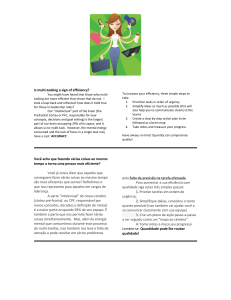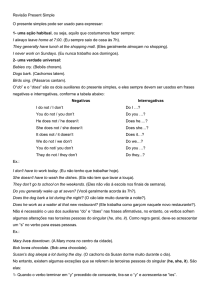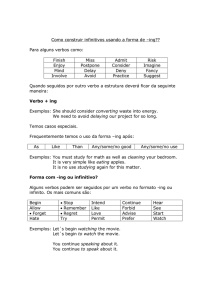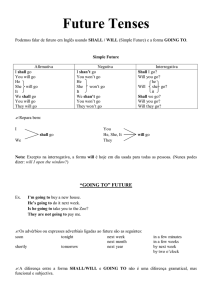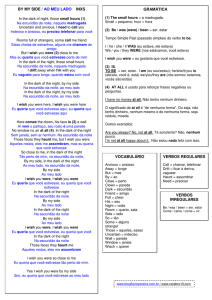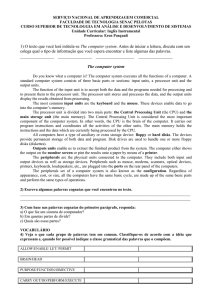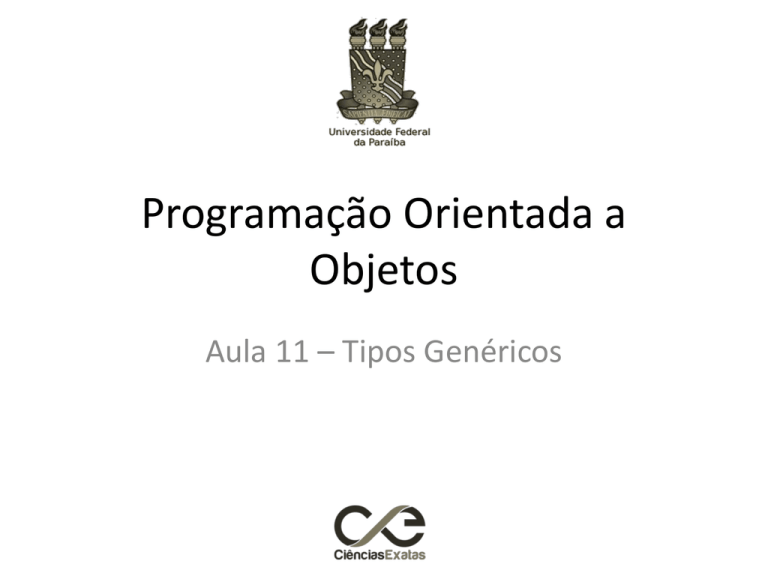
Programação Orientada a
Objetos
Aula 11 – Tipos Genéricos
Qual a diferença?
List l1 = new ArrayList();
List<String> l2 = new ArrayList<String>();
2
Qual a diferença?
3
Antes do Java 5
4
Do Java 5 em diante
5
Diferenças
6
Isso pode!
7
Isso não pode!
8
Antes do Java 5 era +- assim...
9
Semelhanças entre Pré e Pós Java 5
10
Misturando Pré e Pós Java 5 Generics
11
Misturando Pré e Pós Java 5 Generics
12
Misturando Pré e Pós Java 5 Generics
13
Misturando Pré e Pós Java 5 Generics
Remember that compiler warnings are NOT
considered a compiler failure. The compiler
generated a perfectly valid class file from the
compilation, but it was kind enough to tell you
by saying, in so many words, "I seriously hope
you know what you are doing because this old
code has NO respect (or even knowledge) of
your <Integer> typing, and can do whatever the
heck
it
wants
to
your
precious
ArrayList<Integer>."
14
Misturando Pré e Pós Java 5 Generics
• There's one Big Truth you need to know to understand why it runs
without problems—the JVM has no idea that your ArrayList was
supposed to hold only Integers. The typing information does not
exist at runtime! All your generic code is strictly for the compiler.
Through a process called "type erasure," the compiler does all of its
verifications on your generic code and then strips the type
information out of the class bytecode. At runtime, ALL collection
code—both legacy and new Java 5 code you write using generics—
looks exactly like the pre-generic version of collections. None of
your typing information exists at runtime. In other words, even
though you WROTE
15
Resumindo (DICA)
Nunca misture o estilo antigo pré
Java 5 (sem Generics) com o estilo
novo (Java 5 em diante) que inclui
GENERICS!!
16
Polimorfismo e Generics
• Já sabemos que uma referência de List pode
apontar para um ArrayList... porque ArrayList
é um List.
• E isto?
17
Polimorfismo e Generics
• Não, isto não compilará!
• A regra é simples: o tipo da variável declarada
deve corresponder ao do tipo do objeto que
ela aponta!
18
Polimorfismo e Generics
• Se você declarar List<Foo> foo, então, o que
quer que você atribua à referência foo DEVE
ser do tipo genérico <Foo>.
– Não um subtipo de <Foo>
– Nem um supertipo de <Foo>
– Apenas <Foo>
19
Polimorfismo e Generics
• Mas esses estão corretos:
• Até aqui tudo bem...
• Em outras palavras, o polimorfismo só se aplica
ao tipo “base” (List e ArrayList)
• Uma coleção de <JButton> não pode ser atribuída
a uma referência de <Object>, mesmo que
JButton seja um Object.
20
Parece estranho?
Polimorfismo não funciona com Generics da
mesma forma que funciona com arrays!!
21
Polimorfismo – AnimalDoctor Example
22
Polimorfismo – AnimalDoctor Example
• Na classe AnimalDoctor, você poderia ter o
seguinte método:
23
Polimorfismo – AnimalDoctor Example
24
Polimorfismo – AnimalDoctor Example
25
Polimorfismo – AnimalDoctor Example
• Porém, nós poderíamos passar essa lista:
26
Polimorfismo – AnimalDoctor Example
• Para arrays já sabemos que funciona:
E por que para Coleções não funciona de modo
semelhante?
Por causa do apagamento dos TIPOS GENÉRICOS
em tempo de execução! Em tempo de execução,
a JVM sabe o tipo dos arrays mas não o tipo de
uma coleção!
27
Polimorfismo – AnimalDoctor Example
•
As long as the only thing you pass to the addAnimals(List<Animal>) is an
ArrayList<Animal>, the compiler is pleased—knowing that any Animal subtype you
add will be valid (you can always add a Dog to an Animal collection, yada, yada,
yada). But if you try to invoke addAnimal() with an argument of any OTHER
ArrayList type, the compiler will stop you, since at runtime the JVM would have no
way to stop you from adding a Dog to what was created as a Cat collection.
28
Polimorfismo – AnimalDoctor Example
• O código abaixo não compilará:
29
O coringa <?>
• A solução para este problema é usar o coringa <?>
Tudo que passar no teste
É-UM Animal!
• Contanto que você não adicione nada nessa lista!
30
O coringa <?>
31
O coringa <?>
• Com o super você pode adicionar a lista!
– Pare e pense... Faz sentido?
32
O coringa <?>
• If there IS a difference (and we're not yet saying there is), what is it? There IS a
huge difference. List<?>, which is the wildcard <?> without the keywords extends
or super, simply means "any type." So that means any type of List can be assigned
to the argument. That could be a List of <Dog>, <Integer>, <JButton>, <Socket>,
whatever. And using the wildcard alone, without the keyword super (followed by
a type), means that you cannot ADD anything to the list referred to as List<?>.
List<Object> is completely different from List<?>.
• List<Object> means that the method can take ONLY a List<Object>. Not a
List<Dog>, or a List<Cat>. It does, however, mean that you can add to the list,
since the compiler has already made certain that you're passing only a valid
List<Object> into the method.
33
O coringa <?>
• Compila? Sim ou não (por que?)?
34
O coringa <?>
• Compila? Sim ou não (por que?)?
35
O coringa <?>
• By the way, List<? extends Object> and List<?> are
absolutely identical! They both say, "I can refer to any
type of object." But as you can see, neither of them are
the same as List<Object>. One way to remember this is
that if you see the wildcard notation (a question mark
?), this means "many possibilities". If you do NOT see
the question mark, then it means the <type> in the
brackets, and absolutely NOTHING ELSE. List<Dog>
means List<Dog> and not List<Beagle>, List<Poodle>,
or any other subtype of Dog. But List<? extends Dog>
could mean List<Beagle>, List<Poodle>, and so on. Of
course List<?> could be... anything at all.
36
O coringa <?>
37
Declarações de Genéricos
• O <E> representa o tipo que você deve passar.
• Quando você codificar, você poderá criar um
List<Dog> ou um List<Integer>, e daí por diante.
• By the way, o “E” é apenas uma convenção.
Qualquer identificador Java funcionaria aqui, mas
“E” significa “Element”, e é geralmente utilizado
para genéricos em coleções.
• Outra convenção é utilizar “T” (para “Type”) para
qualquer outra coisa que não coleções.
38
Declarações de Genéricos
• Em outras palavras, o que quer que seja “E”
quando você instanciar a Lista, é isto que você
poderá adicionar a ele.
39
Criando sua própria classe Genérica
• Vamos criar uma classe para gerenciar os
aluguéis de algum empreendimento:
40
Criando sua própria classe Genérica
• Suponha agora que você quer torná-la
específica para carros:
41
Criando sua própria classe Genérica
• O jeito correto:
42
Criando sua própria classe Genérica
43
Outro exemplo
44
Outro exemplo
45
Outro exemplo
• Tipos genéricos “limitados”:
46
Criando métodos genéricos
Declaração do tipo genérico
Chamando o método com um objeto Dog
47
Referências
• SCJP 6 – Livro de certificação do Java
48


